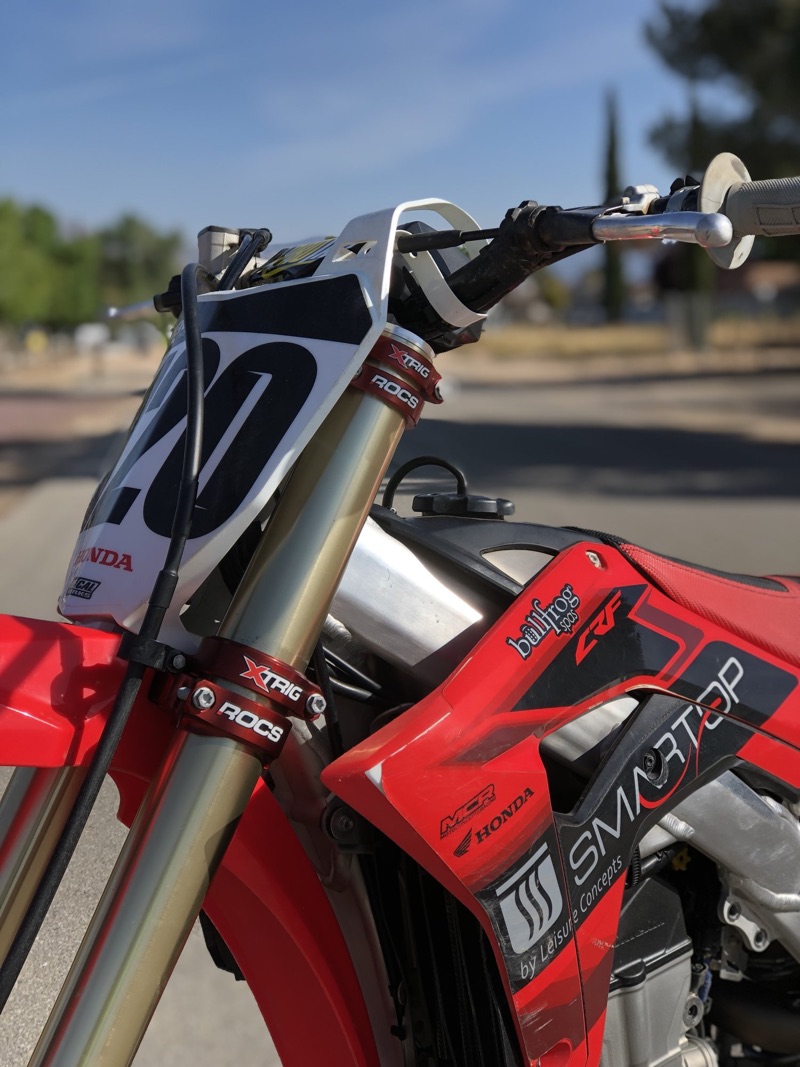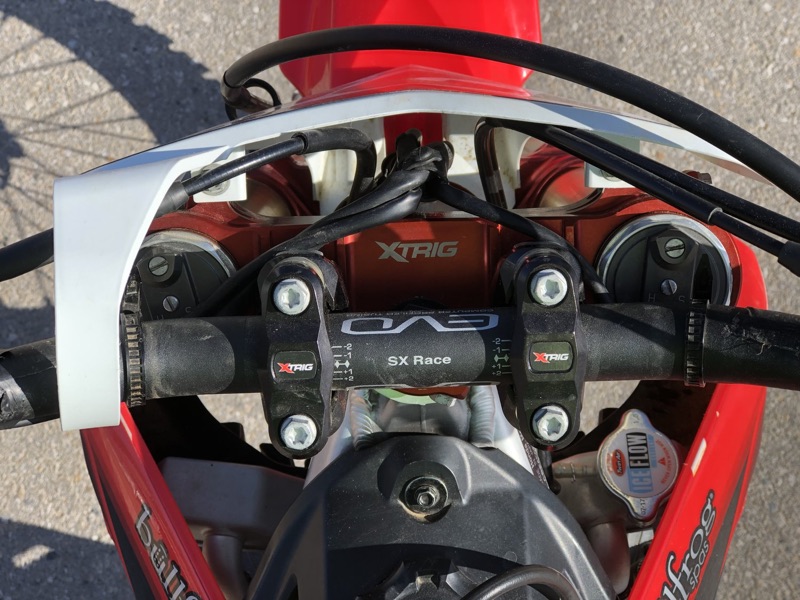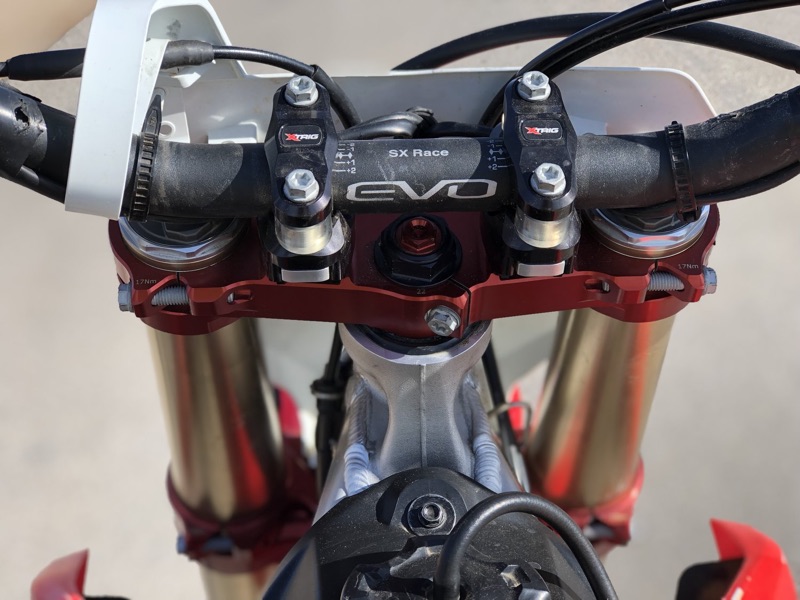Share This Article
I have been getting ready for the first two AMA outdoor nationals and knew that I was going to be running an aftermarket triple clamps and those clamps would be X-Trig. Since my practice bike was my test bike, I thought it would be beneficial to get a set of X-Trig clamps to ride/test with to make sure I could get the “feel” of an aftermarket triple clamp, since I am so used to riding with the stock clamps on the 2019 Honda CRF450R. Like I have spoken about before, it’s tough to find aftermarket triple clamps that perform better than stock these days. So much R&D is involved (at the OEM level) in making a triple clamp that flexes enough, but also has enough rigidity to aid the machine under load/through corners as well. With the triple clamp flex character so important to each specific chassis (on all motocross bikes) sometimes it’s tough to find anyone that can make a “comfortable” set of aftermarket triple clamps. Why do you need aftermarket triple clamps? Well sometimes it’s just for looks with some riders, but there are occasions where you might want another offset to help you get more stability or a sharper turning character out of your machine. In this case I was simply wanting to make sure that I wouldn’t be trading comfort for stiffness on the Honda CRF450R somewhat finicky chassis setting.

Enter X-trig’s ROCS Tech Triple Clamps and PHDS Mounts. “ROCS” stands for “Revolutionary Opposing Clamp System”. The ROCS clamp allows for precise alignment of the fork tube with opposing clamping surface patterns, the stiffness of the steering stem is specifically tuned to the respective motorcycle model, the steering-head bearing is already mounted on the shaft tube for convenience, a special fork slot and clamping area for precise fork operation, precise clamping with special screws for low torque specs, OEM attachments can be mounted without auxiliary material, and flexibility that is adapted to the fork with anodizing in the technical factory OEM look. The difference between the ROCS “Tech” and the ROCS “Pro” is the “Tech” uses a standard offset with a pressed shaft tube. The “Pro” has two offsets you can choose from by simply adjusting the shaft tube (or steering stem). I felt it would be beneficial to try another offset with the Honda CRF450R for testing purposes, so I went with the ROCS Pro clamps.
The PHDS (Progressive Handlebar Dampening System) is a system supported by elastomers designed to absorb engine and chassis vibrations. The system also dampens the forces acting on the handlebar in a horizontal and vertical direction, maintaining steering precision. The handlebar can be adjusted in 12 different positions when the PHDS is mounted. The Honda vibrates more in the handlebar area than any other 450 aluminum framed motocross bike, so this is something that I feel the Honda needs, in my opinion.
Installation of the ROCS clamp is fairly straight forward (with the pressed shaft tube). All you need to do is grease up the steering head bearing and slide the bottom clamp up in the head tube of the frame. All of the front fender mounting points and even the OEM hour meter bolts up the same way with the X-trig clamps. Super clean! Mounting up the PHDS bar mounts is a little tricky as the mounts themselves have a lot of moving parts, so make sure to read the instructions to ensure proper mounting. Technical Touch offers optional PHDS bar mount elastomers that come in soft or firm, but I chose to run the stock medium style elastomers, which seem to be just fine for motocross conditions.

I am super picky about bar positioning, shocking I know, so I went with the mounting hole closest to me (when sitting on bike) on the triple clamp with the PHDS mounts forward. This handlebar position gave me a +1 mm bar position (forward from stock), which I preferred as the stock Honda rider triangle is just fine for my 6’0 frame. The PHDS bar mount itself is the same height as the stock bar mount, which also was good for me and I mated the clamp/mount with a Pro Taper EVO SX RACE handlebar. Having so many positions available for the rider is definitely a huge positive for adjustability with these ROCS clamps. If you feel like you need a higher PHDS handlebar mount, X-trig also offers spacers to go under the PHDS mounting system. You can pick from 3mm, 5mm, and 10mm spacers.

So what did the X-trig ROCS Tech Triple Clamp and PHDS handlebar mounts do on the track? My goal for this test was to not gain front end rigidity, get a more precise front end feel through corners, without getting deflection on hard pack/rough straights. Basically trying to NOT get a harsher ride on the Honda, tough to do right? The good news is that this is exactly what I found with the X-trig ROCS Tech/PHDS system, but there is some fine print that I want to fill you in on. The X-trig ROCS Tech clamp on the CRF450R provided enough flex and doesn’t feel like it negatively affected front end bump absorption, but was also stiff enough to give me a positive front wheel feel through flat corners. The ROCS Tech clamp is most noticeable when diving deep into a rut where there is a huge load put on the front end, forced by the rider. The chassis positivity through this area is better than the stock clamps. The stock clamps has a tendency to flex too much and give the rider a wiggle immediately off throttle (on deeply tilled tracks or soft dirt) or give the rider an unsettled (dive) when dropping into a long/deep rut (this sensation can only be felt mostly by faster or heavier riders). The X-trig ROCS Tech clamp gives the front end less wallow (firmer) and more cornering stability (without upsetting chassis balance). Straight line stability is as good as stock and front end bump absorption is only minimally stiffer feeling on braking bumps/square edge.
Optional Setting: I have tried the ROCS “Tech” with the pressed steering stem shaft as well and that set up is a little firmer of a feel as well as provided a little more rigidity (I found out this when I went to ride my race bike, which has the “Tech” installed). The differences are small, but I did feel it nonetheless. Going to a 24mm offset on the ROCS “Pro” helped the Honda settle down on faster tracks. Running the fork up 4mm with a 24mm offset really helped calm this chassis down for 2:00PM motos (AKA ROUGH TRACKS). The 24mm offset did affect the Honda’s turn in capabilities and made it feel slightly heaver through corners. If you’re looking to slow the chassis down on faster tracks try going to the 24mm offset, 105mm’s of sag, and the fork up 4mm.
The PHDS mounts do not vibrate nearly as much as the OEM rubber mounted bar mounts. The PHDS bar mounts flex as good as stock with the standard elastomers (up and down), but dampen vibration noticeably better around the track (especially at higher RPM’s). Slap down landings are improved slightly and front end positivity (entrance into corners) are as good as an OEM feel. Simply put, the vibration characteristics the PHDS mounts provide are well worth their weight in gold. I use “weight” because they are heavier than stock ones by quite a bit, but I will gladly take some extra ounces over vibration any day.
The cost of the X-trig ROCS Tech Triple Clamps and PHDS handlebar mounts are $900.00. The cost is more expensive than other triple clamps out on the market by a couple hundred bucks. However, there are only two triple clamps that I have tested, that to me, are as good or better than stock. If you’re looking to get a set of clamps for the temperamental Honda CRF450R “vibes” pick up some front end cornering stability, get an optional offset, and even improve the looks of your Honda, X-trig has some really nice clamps and handlebar mounts available for your red motocross machine. You can check out and purchase all of the X-trig products over at technicaltouchusa.com.
If you have any questions about this test please feel free to email me at kris@keeferinctesting.com.
